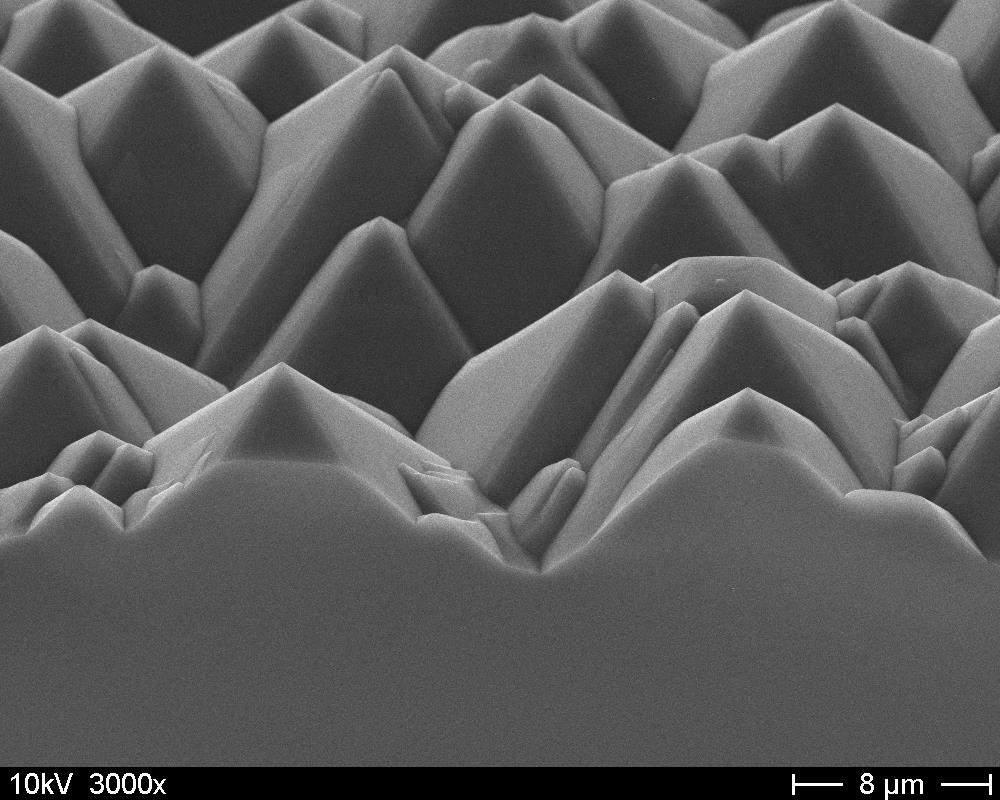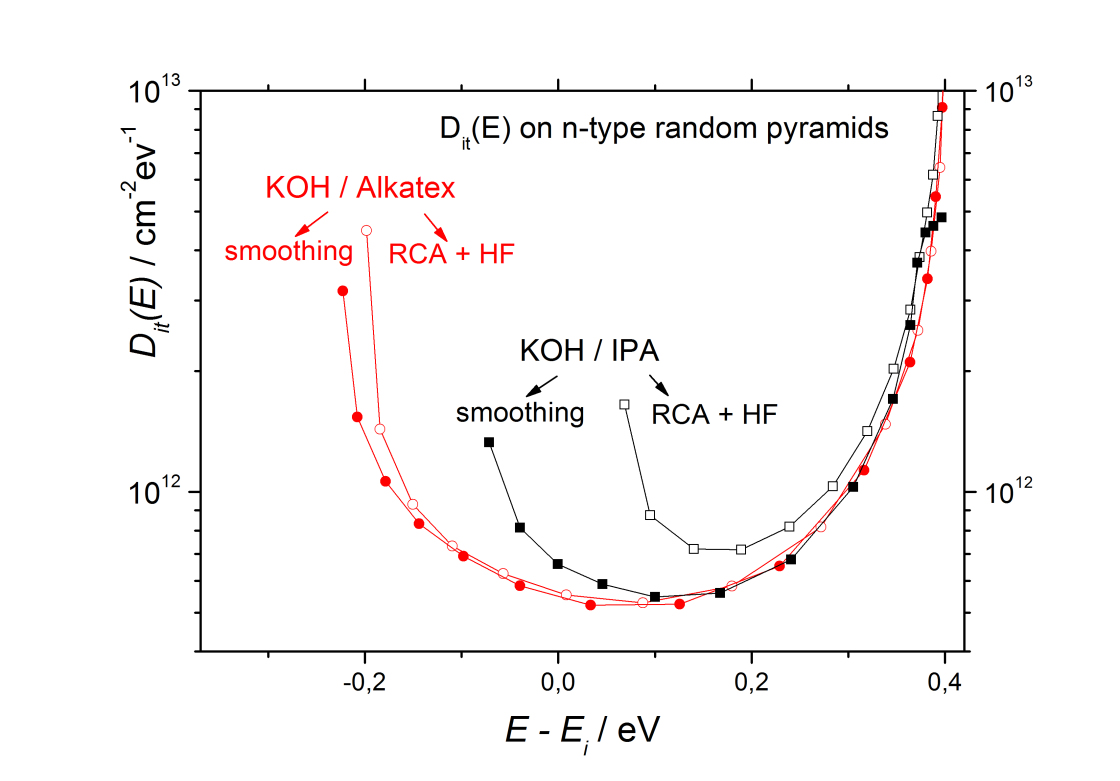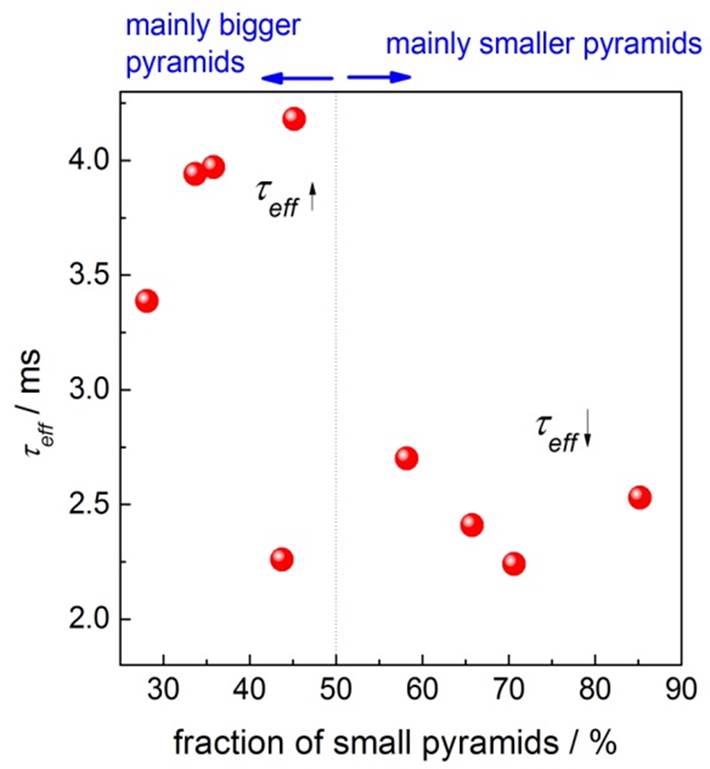Institut Silizium-Photovoltaik
Reduce of reflection and recombination losses by surface texturization
Homogeneous pyramid formation is very sensitive to residual contaminants and crystal defects. Surface texturing is conventionally achieved by anisotropic wet-chemical etching of Si(100) wafers in alkaline solutions containing isopropyl alcohol (IPA) (is 70 - 80 °C ) as an additive. IPA easily evaporates resulting in a continuous change of the etching solution concentration. In order to avoid these disadvantages IPA can be substituted by an IPA-free additive, i.e. Alkatex ZeroTM (GP Solar GmbH). This feature promotes a more homogeneous surface structure and allows tuning the pyramid size distribution.
The texture etching time has to be optimised to reduce reflection as well as recombination losses.
Reflection losses can be reduced with decreasing fraction of small pyramids. Both the depth of the saw damage etching (SDE) and the duration of the texturization etching have crucial influence on the resulting pyramid size distribution.
Interface recombination behaviours result from 2 opposed effects during longer etch times: (i) the further decrease of saw damage enhances carrier life time but (ii) higher fraction of small pyramids increases number of defects. By intermediate saw damage removal and texture etching times in (IPA)-free KOH solution the densities of electronic interface states were found to be strongly decreased (Dit,min < 5 10-11 cm-2eV-1), in comparison to pyramids prepared in IPA containing solutions.
Publikationen
- Stegemann, B.; Kegel, J.; Korte, L.; Angermann, H.: Surface Optimization of Random Pyramid Textured Silicon Substrates for Improving Heterojunction Solar Cells. Solid State Phenomena 255 (2016), p. 338-343
- Kegel, J.; Angermann, H.; Stürzebecher, U.; Conrad, E.; Mews, M.; Korte, L.; Stegemann, B.: Over 20% conversion efficiency on silicon heterojunction solar cells by IPA-free substrate texturization. Applied Surface Science 301 (2014), p. 56-62
- Kegel, J.; Angermann, H.; Stürzebecher, U.; Stegemann, B.: IPA-free texturization of n-type Si wafers: Correlation of optical, electronic and morphological surface properties. Energy Procedia 38 (2013), p. 833-842
- Stegemann, B; Kegel, J.; Stürzebecher, U.; Gref, O.; Varache, R.; Laades, A.; Gottschalk, Ch.; Wolke, K.; Angermann, H.; Conditioning of Textured Si Solar Cell Substrates by Wet-Chemical Treatments: Evaluated by Surface Photovoltage (SPV) Measurements. Proc. of the 27th EU PVSEC - European Photovoltaic Solar Energy Conference and Exhibition Frankfurt (Main), Germany, (2012) pp. 547 - 551
- Angermann, H.; Gref, O.; Laades, A.; Conrad, E.; Klimm, C.; Stürzebecher, U.; Michael, D.;Stegemann, B.: Characterization of wet-chemically pre-treated silicon solar cell substrates and interfaces by surface photovoltage (SPV) measurements. In: Ossenbrink, H. [u.a.] [Eds.] : 26th European Photovoltaic Solar Energy Conference 5 - 9 September, Hamburg, Germany. München: WIP, 2011. - ISBN 3-936338-27-2, p. 1593-1597
- Angermann, H. ; Conrad, E. ; Korte, L. ; Rappich, J. ; Schulze, T.F. ; Schmidt, M.: Passivation of textured substrates for a-Si:H/c-Si hetero-junction solar cells: Effect of wet-chemical smoothing and intrinsic a-Si:H interlayer. Materials Science and Engineering B 159-160 (2009), p. 219-223
- Sievert, W. ;Zimmermann, K.-U. ; Hartmann, B. ; Klimm, C. ; K. Jacob, K. ; Angermann, H.: Surface texturization and interface passivation of mono-crystalline silicon substrates by wet chemical treatments. Solid State Phenomena 145-146 (2009), p. 223-226
- Angermann, H. ; Conrad, E. ; Korte, L. ; Rappich, J. ; Schulze, T.F. ; Schmidt, M.: Passivation of textured substrates for a-Si:H/c-Si hetero-junction solar cells: Effect of wet-chemical smoothing and intrinsic a-Si:H interlayer. Materials Science and Engineering B 159-160 (2009), p. 219-223



